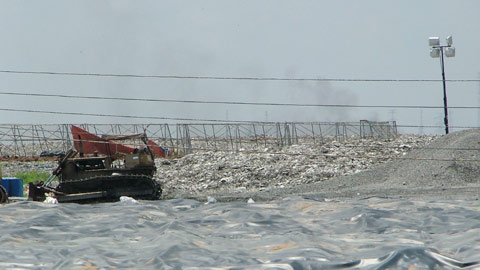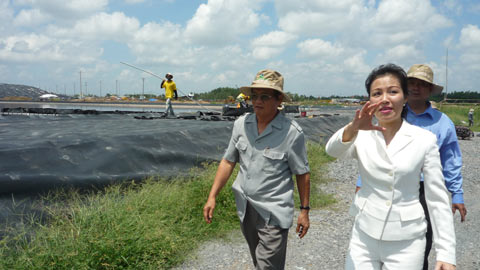
| The “secrets’ behind HCM City’s ‘state-of-the-art’ waste treatment project | ||||
When it was opened in November 2007, the USD90 million Da Phuoc solid waste treatment complex in HCM City was praised for its modern technology. However, local residents have complained of fetid smells, fly pandemics and discharge of waste water to the surrounding canals. That’s only a few of the problems that devil the Da Phuoc project. The Da Phuoc Integrated Waste Management Facility is surrounded by rivers and is connected to the road by a bridge. Its only entrance is strictly controlled. Inspection groups and delegations all visit the complex through the main gate -- and only see the front of the site.
The facility is operated by Vietnam Waste Solutions (VWS), a subsidiary of a successful northern California (US) company owned by a Viet-kieu (émigré) family. In its prospectus, VWS promised that the Da Phuoc complex “will responsibly address the challenge of Ho Chi Minh City´s increasing amount of solid waste that is a by-product of the City´s growing economy. Our project will increase recycling, help to save the environment and provide many new jobs for local residents.”
VWS boasts a plant that treats and purifies the liquid that oozes from the waste and this has been demonstrated to inspectors. Looking at the clean and tidy front site, it’s easy to think that this is a modern waste treatment plant that meets environmental criteria.
Untreated waste liquids are finding their way into the river
However, since early 2009, local fishermen have seen black water flowing near the complex. The dirty water often appears at night or when it rains.
A local fisherman said “the river water is getting dirty so the volume of fish and shrimp in this area is falling. To know whether they discharge waste water to the river or not, you have to go behind the dump.”
Disguised as fishermen, a reporter used boats to approach the dump from behind during a rainy day in July 2009. They filmed and took photos. They found a reservoir discharging strong-smelling reddish brown water to the river. After rains, the reservoir water turned to a light red brown.
Later, in early August 2009, the reporter returned to Da Phuoc and saw that ditches that lead water from the reservoir to the river were full. The water in the reservoir was green. Whenever the wind blew, the water bubbled up and the smell carried.
The reporter obtained some documents from the management board of HCM City Waste Treatment Complexes, the oversight unit of the HCM City Department of Natural Resources and Environment (DONRE). They indicate that since Da Phuoc was put into operation, a large volume of water leached from the waste has not been treated.
The complex receives 3000 tons of waste per day which releases around 800 cubic meters of wastewater.
A report dated March 19, 2009 signed by DONRE’s Solid Waste Management Division said that at the end of February 2009, VWS was able to treat 150 cubic meters of wastewater each day.
That suggests that the volume of untreated waste water left at Da Phuoc is huge. And, during downpours, it is highly possible that water in the complex’s reservoirs overflows.
Since early 2009, there have been dozens of downpours. How did the Da Phuoc complex deal with the volume of waste water on these occasions?
This waste treatment complex has been operational for nearly two years but HCM City’s supervision agency – the aforesaid Management Board of HCM City Waste Treatment Complexes -- has not yet had full access to the waste treatment at Da Phuoc.
In a report to HCMC DONRE in March 2009, the management board admitted that it has been unable to supervise this dump. It said that it could only record the volume of waste shown by the electronic meters and these are run by VWS.
MPI says HCMC agreed to pay too much
According to DONRE reports dated August 12 and July 22, 2009, the total investment by Vietnam Waste Solutions Co. (VWS) in the Da Phuoc project is USD 90 million and the charge for treating one ton of waste is USD16.40. The charge will increase by three percent each year over the 22 year life of the contract.
The project was controversial from the beginning. Several times the Ministry of Planning and Investment (MPI) rejected it, calling that the investor’s financial capability weak and the proposed waste treatment fee high. A July 12, 2005 MPI report to the Prime Minister, MPI pointed out that a bid by the Lemna group (also an American company) was only USD5 per ton.
In an October 24 follow-up report, MPI was unswayed by arguments in support of VWS by the HCM City People’s Committee. However, at last MPI granted a licence allowing VWS to implement the Da Phuoc waste treatment complex.
At a session of the HCM City People’s Council on July 8, 2009, deputy Le Thuong Man said that according to VWS’ report, by June 2009 this firm had invested USD51 million in the Da Phuoc complex (not audited yet).
The facility began operations on November 1, 2007 and receives around 3000 tons of waste per day. Thus, HCM City has to date paid more than USD25 million of waste treatment fees for VWS, in addition to the USD9 million that the city paid VWS in advance. All told, the investor received more than USD34 million.
Over the facility’s projected 22 years of operation under VWS management, HCM City will have to pay VWS over USD393 million.
Why did HCM City have to pay USD9 million in advance?
The investor of Da Phuoc project enjoys many incentives. VWS was allocated 128 hectares of land tax and rent-free 50 years. The city also paid USD9 million in advance. With this sum, the investor was able to build many facilities before receiving waste deliveries.
In its January 2005 feasibility report, VWS asked the Prime Minister, the HCM City People’s Committee and related agencies to consider and approve this report with the following main contents:
In the first phase, the facility has a designed capacity of two million tones, with investment of USD16.18 million. HCM City will “temporarily allocate” USD9 million. This is the cost for six months of processing waste.
On June 10, 2005, the HCM City People’s Committee agreed to “temporarily allocate” USD9 million for VWS to build a bridge and infrastructure facilities.
However, in a deal inked between the HCM City Department of Natural Resources and VWS on February 28, 2006, this USD9 million sum was called “money paid in advance”.
Money that is “temporarily allocated” and money that is “paid in advance” would seem to be quite different things. It’s clear that the user of ‘temporarily allocated money’ would have to re-pay the sum, whereas ‘money paid in advance’ may be considered as a non-refundable investment in infrastructure.
Up to today, there’s still a question whether the feasibility study for the project was reviewed and approved by competent bodies? And on what basis was the contract signed?
In its October 24 report to the Prime Minister, MPI commented that “paying USD9 million in advance is a huge investment compared to the total investment for the first phase (USD30 million). It is in the nature of providing investment capital for this project”.
According to VWS, the USD9 million covered the cost of building a bridge, dikes and the landfill area to receive the waste.
Many HCM City legislators argued that USD9 million was excessive, sufficient for VWS to build many facilities before receiving rubbish.
Why is HCM City paying so much just to get waste buried?
According to the agreement between HCMC DONRE and VWS, VWS was to build a landfill that could can receive 3000 tons of waste a day, a compost fertilizer plant with a daily capacity of 1000 tons, a plant to treat 1200 cubic meters of water leached from the waste per day and a waste classifying plant with a daily capacity of 500 tons. However, since the day it was put into operation, Da Phuoc has only buried rubbish. It doesn’t even have a transfer point and conveyer belt to move trash from arriving dump trucks into the landfill, though all of these expenditures were projected in the rubbish treatment unit price.
When HCM City’s deputies questioned the HCMC DONRE about this issue, the department said that the money they paid VWS was “temporarily calculated”.
According to DONRE’s oversight unit, since it started running until the end of February 2009, Da Phuoc has received over 1.2 million tons of rubbish. HCM City therefore has ‘temporarily paid’ VWS over 319 billion dong, equivalent to USD19.1 million.
VWS recently proposed to raise its waste treatment fee by three percent, the yearly increase provided for in its contract. HCME DONRE recommended the HCM City approve this request.
In May 2009, a group of HCMC National Assembly deputies visited Da Phuoc. Afterward, they asked the authorities to tighten supervision over this project because the city has a huge commitment to this project. The deputies said HCM City has to pay VWS up to USD18 million per year for treating rubbish. The investor has claimed it disbursed 50 percent of the total capital in this project but that report has not been audited yet. Deputies asked HCM City to check up on VWS financial capability in this project.
To the deputies, the landfill project smells conceptually as well as actually. They asked why the investor hasn’t yet built other facilities to process waste, but has only buried it. “The public is wondering if the investor wants to fill up this ground as soon as possible so it can build a golf course. Who will make clear why the city budget has to pay a lot of money for burying waste,” asked Tran Du Lich, chief of the delegation. | ||||
| Vietnamnet |

